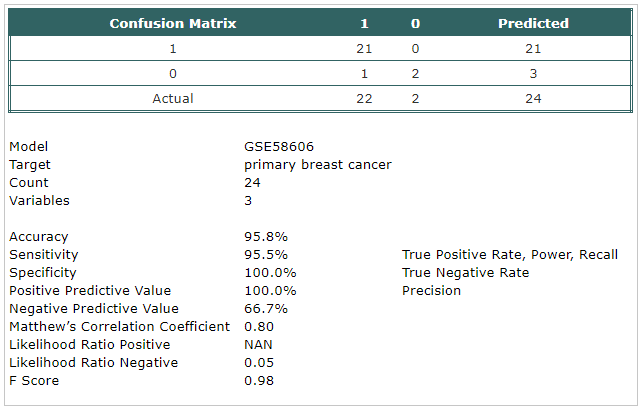GSE58606
|
| What
We Learned |
- Because stage of the disease at diagnosis is associated with prognosis, efficient diagnostic tools for early detection are keys to survival.
|
- Breast cancer detection:
- Biopsy is the method used to establish a definitive diagnosis, but it is an invasive procedure.
- Mammography is the most reliable way to detect breast cancer, it has some limitations.
- Serum tumor markers such as carcinoembryonic antigen or cancer antigen 15–3, although promising at the time of their identification, are not recommended by the American Society of Clinical Oncology and other expert panels for screening or diagnosis of breast cancer because of their low diagnostic sensitivity in
early stages of the disease.
- Biomarkers (e.g. microRNAs)
|
- Circulating miRNAs have been attracting the attention of researchers because they are highly stable, resistant to degradation, and easily obtained by noninvasive procedures
- Their stability can be partially explained by 2 mechanisms: protection of secreted miRNAs by the membrane of vesicles of endocytic origin called exosomes
and stabilization of secreted miRNAs by their association with RNA-binding proteins.
|
- Among the most deregulated miRNAs, miR-125b-5p and
miR-21-5p have been repeatedly associated with breast cancer.
- miR-21-5p is known to function as an oncogene by targeting
tumor suppressor genes including tropomyosin 1, programmed cell death 4, and phosphatase and tensin homolog, leading to cell proliferation and inhibition of apoptosis and regulation of cancer invasion and metastasis in breast cancer.
|
- Dissimilar patterns of miRNA expression between tumor and plasma have been reported recently.
- Pigati et al. studied the liberation of miRNAs from malignant and nonmalignant mammary cells into body fluids and suggested that miRNAs are released from breast cancer cells in a
selective manner, and therefore, extracellular and cellular miRNAs profiles are different.
|
- The classifier for the breast tissue
samples had 100% accuracy but 70% for the plasma samples.
|
|
| What
We Did |
- A classification model has been built using Trainset.
The selected probes were:
- hsa-mir-3656
- hsa-mir-4721
- hsa-mir-3942-5p
|
- The model has been tested using Testset.
Both Trainset and Testset are from the breast tissue samples.
|
 |
|

